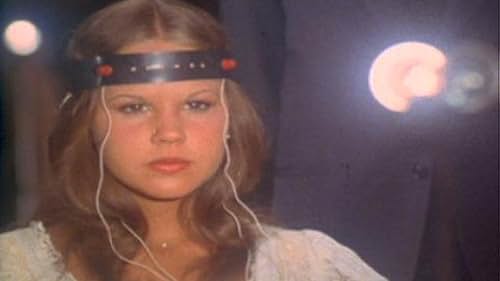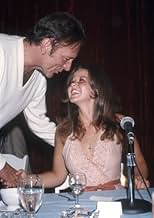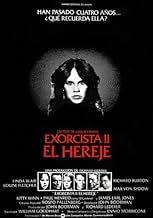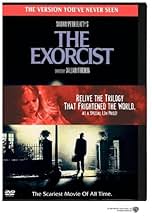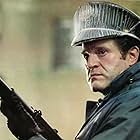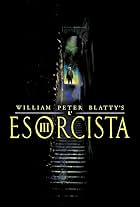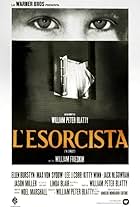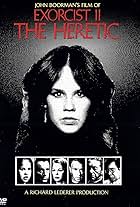Un'adolescente che una volta era posseduta da un demone scopre che vive ancora dentro di lei. Nel frattempo, un prete indaga sulla morte dell'esorcista della ragazza.Un'adolescente che una volta era posseduta da un demone scopre che vive ancora dentro di lei. Nel frattempo, un prete indaga sulla morte dell'esorcista della ragazza.Un'adolescente che una volta era posseduta da un demone scopre che vive ancora dentro di lei. Nel frattempo, un prete indaga sulla morte dell'esorcista della ragazza.
- Premi
- 3 candidature
- Liz
- (as Belinha Beatty)
Trama
Lo sapevi?
- QuizThe original cast and crew of L'esorcista (1973) were very much opposed to a sequel. William Friedkin and William Peter Blatty actually met to discuss ideas at one point, but when they failed to develop a suitable premise, they abandoned the project. Both Linda Blair and Ellen Burstyn turned down repeated offers by the studio, though Blair eventually agreed to return when presented with what she considered a good script. However, according to Blair, due to various rewrites the script ended up a total mess. By that point, however, she was contractually bound to a sequel, and unable to drop out of the project.
- BlooperThe institution where Regan receives treatment has glass offices in which you can see the patients and their counselors with the only privacy being offered is by audio. Glass rooms in actual institutions usually have blinds/ curtains to provide visual privacy.
- Citazioni
Regan MacNeil: What's the matter with you?
Sandra Phalor: [hesitant, stuttering] I'm autistic.
Regan MacNeil: How do you mean?
Sandra Phalor: I'm withdrawn. I can't talk.
Regan MacNeil: But you're talking now.
Sandra Phalor: [shakes head no]
Regan MacNeil: Yes, you are. I can hear you.
Sandra Phalor: You can hear me?
Regan MacNeil: Sure!
Sandra Phalor: [pause] What's the matter with you?
Regan MacNeil: I was possessed by a demon. Oh, it's okay. He's gone!
- Curiosità sui creditiTap Dance Routine Choreographed by Daniel Joseph Giaghi
- Versioni alternativeExorcist 2 exists in at least three versions. The original version was 117 minutes long and was recut by director John Boorman the day after the premiere into a 110 minutes version, the one released theatrically. Major differences include the addition of a recap of the events of the first film through narration and freeze frame. Using stock shots of Linda Blair from the first film for the climax (all new shots of Regan possessed were done by a double because Linda Blair refused to have the possession makeup done on her again) and an alternate ending where Richard Burton's character is killed (In the original version, he runs off with Regan to help her be a force of good). The European version is also purported to be different. For a long time, only the recut version of Exorcist 2 was available for TV, cable and on video. Recently, the original 117-minutes cut has found its way to video and recent TNT airings.
- ConnessioniEdited into Exorcist II: The Heretic: Alternate Opening (1977)
- Colonne sonoreLullaby of Broadway
(uncredited)
Music by Harry Warren
Played on the saxophone while Regan is tap dancing
When Blatty declined to write Warner Bros.' sequel, John Boorman and his creative associate Rospo Pallenberg developed an original script from a treatment by playwright William Goodhart, the credited screenwriter. Boorman accepted the project as a means to artistically express metaphysical ideas in which he was absorbed. The link to Teilhard De Chardin provided an ideal venue. The story of Father Lamont's spiritual odyssey is specifically a meditation on the Grail Quest theme, derived from Celtic mysticism and Arthurian legend, which underlie a thematically-related sequence in Boorman's early work: DELIVERANCE, ZARDOZ, EXORCIST II: THE HERETIC, Excalibur and THE EMERALD FOREST, comprising an important cinematic exploration of the Quest as Initiatory path.
In EXORCIST II: THE HERETIC, the late Father Merrin's reputation has fallen into disrepute and Father Lamont (Richard Burton), suffering a crisis of faith, is ordered by the Cardinal to investigate "the circumstances surrounding the death of Father Merrin" and the legitimacy of the exorcism before Merrin's papers (his life's work) can be released.
The title character of THE EXORCIST was that of Father Merrin (Max Von Sydow); this role then passed to the younger priest, Father Karras (Jason Miller). Just so, the heretic in EXORCIST II is initially Merrin until, through young Regan (Linda Blair), Father Lamont makes contact with the mind of Merrin and in that psychic joining shares his vision. Thus Lamont's descent into (and beyond) heresy is an initiatory quest which deepens as he goes against the Church's orders and ultimately calls upon the demon for guidance to the "evil heart" of the mystery.
In the scene at the Natural History Museum, the attentively listening viewer will discover (in the full 117-minute version) that Father Lamont tells Regan about Teilhard de Chardin and briefly explains the World Mind theory. The science-fictional device called the Synchronizer allows the World Mind concept to be expressed in cinematic images. (Among the many differences between this film and THE HERETIC is that the original's emphasis is strongly verbal whereas THE HERETIC expresses its complex ideas almost entirely in visual and symbolic terms.) A distinction is drawn between the peace and unity of the World Mind and the insanity ("evil") and corruption of its opposite, the ego: a state of separation from consciousness which mimics the One-Mindedness of God or the Universe. In THE HERETIC, this imitation or false Christ is symbolized by Pazuzu, the Babylonian genie and locust god--one of many "heathen" idols demonized in the Judeo-Christian tradition. (The demon was named in Blatty's novel but not in the original film.) Its activity of separation masked as joining is symbolized by the locust swarm which forms a single-mindlessness ("a Locust Mind, if you will") in mockery of Whole (Holy) Consciousness (Spirit). The resulting psychic fragmentation is reflected in the mirror images which permeate the film. Regan represents an evolutionary step toward the "Omega Point", the healing of the separation; a forerunner of Kubrick's Star Child.
John Boorman's film doesn't spell itself out for the viewer any more than does Kubrick's 2001: A SPACE ODYSSEY and there is no Arthur C. Clarke novel to "explain it all for us". Boorman intends THE HERETIC to stimulate intelligent and imaginative thought and speculation. Where Kubrick and Clarke's ideas (initially met with great perplexity) have long been sanctioned as worthy of consideration, Boorman's somehow flew over the heads of a viewer-ship which, threatened by the film's non-dualistic subversion of the original's simplistic "good vs. evil" formula, has for thirty years ridiculed a misunderstood artwork. The original mass audience which condemned the film on first release was fresh from making the relatively ghastly Italian EXORCIST imitation Beyond the Door a huge box office success because it gave them what they wanted and only what they wanted: puke, puke and more puke. And so like the swarming locusts, the mundane Philistine mentality endlessly repeats the hypnotic chant: "worst sequel, worst sequel, worst..." There is no actual "Director's Cut" of EXORCIST II: THE HERETIC. The 117-minute Theatrical Version is John Boorman's official cut.
During the disastrous initial release, Warner Bros. hastily issued instructions to theaters to remove specified sections of the film which had drawn audience hostility, without consulting the director. Under extreme pressure, Boorman subsequently prepared a third, more carefully edited version for the international release. The re-editing rendered a difficult and highly symbolic film incomprehensible to the horror-show expectations of the audience. The most significant deletion was the discussion of Teilhard de Chardin's World Mind theory, the central focus of the film.
This bastardized version debuted on cable in the United States and for a decade the film was available exclusively in this distorted form. The full-length version, unseen since the early weeks of the initial release, was restored in the late 1980's for home video and is currently available on DVD. Mercifully, the Butcher's Cut has been permanently withdrawn.
Given his experience with the film, it is unlikely that Boorman would involve himself in a new Director's Cut edition. Given the mindless disrespect shown the film, he seems to have washed his hands of it and its detractors.
Rating: EXTRAORDINARY.
- Doctor_Mabuse1
- 22 gen 2009
- Permalink
I più visti
Dettagli
Botteghino
- Budget
- 14.000.000 USD (previsto)
- Lordo Stati Uniti e Canada
- 30.749.142 USD
- Fine settimana di apertura Stati Uniti e Canada
- 6.735.000 USD
- 19 giu 1977
- Lordo in tutto il mondo
- 30.749.142 USD
Contribuisci a questa pagina


